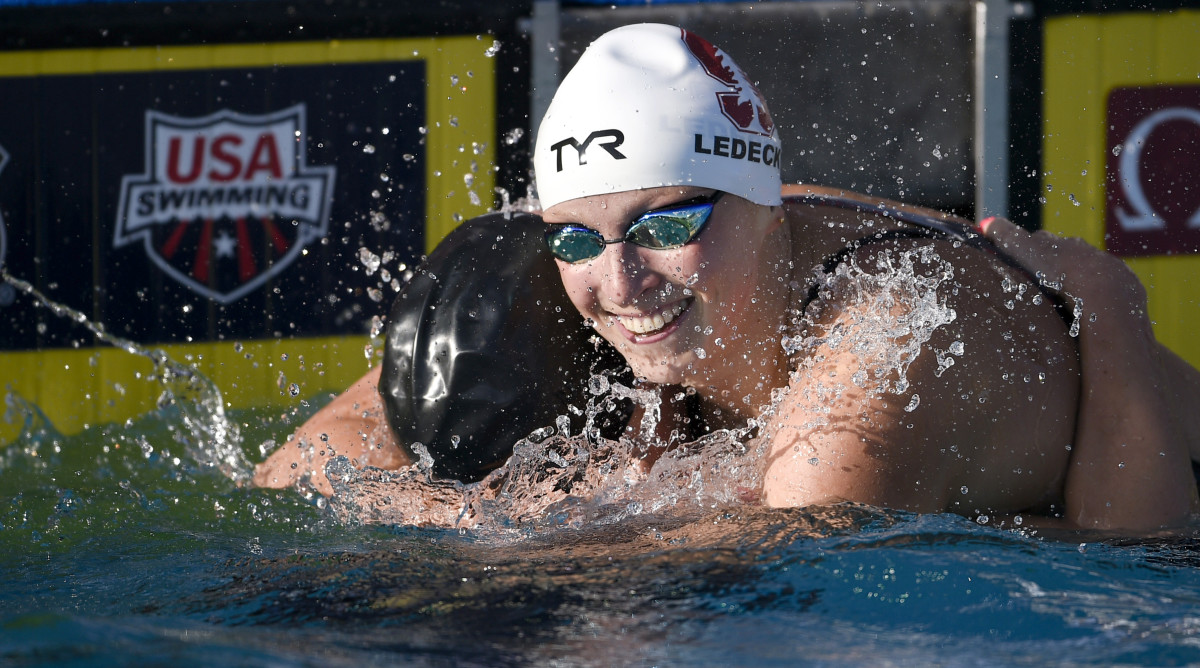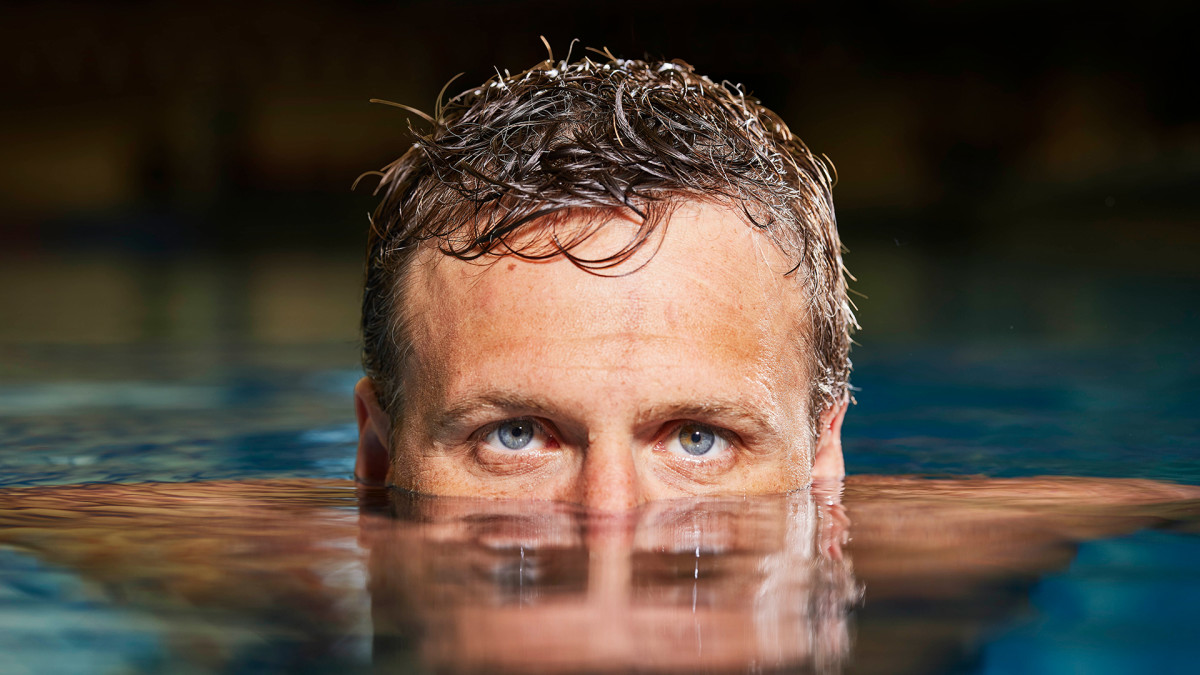Five Story Lines to Watch at U.S. Olympic Swimming Trials
One of the most pressure-packed sporting events in the world begins Sunday. The U.S. Olympic Trials for swimming is a crucible like few others in athletics, with lifetime hopes and dreams fulfilled or dashed by hundredths of seconds.
In no other country is the competition as fierce for two spots in each event, and nobody else stages its swim trials in a 17,000-seat basketball arena. It is a test that can fry even the strongest of minds. “One of the worst days of my life is the day I made the Olympic team,” says Maya DiRado, who would go on to win four medals in Rio de Janeiro (two of them gold) after enduring the nerves that beset her in Omaha.
DiRado, a whip-smart Stanford graduate, was favored to win the 400-meter individual medley on the first day of trials in 2016. Racing through that burden was nearly crippling. “The pure terror and stress I felt until 7 p.m., when I flipped at 350 [meters] and was pretty sure I was going to make the Olympic team, was horrible,” she says. “It’s the most intense swim meet anyone will ever go to. But there is a benefit to Team USA. We walked into Rio and it was easy.”
The U.S. will hope it walks into Tokyo next month with similar confidence. But to get to Japan you must go through Nebraska. Here are five main story lines to monitor as the meet unfolds from June 13–20:

1. Who fills the post-Phelps vacuum?
Nobody really replaces Michael Phelps. There is no duplicating his 28 medals, 23 of them gold, or the star power that elevated swimming to its highest level of Olympic popularity during his run from 2000 to '16. But the U.S. certainly does not lack star power.
The greatest swimmer on the planet is still Katie Ledecky, the distance dominator who gets to add another event to her repertoire with the inclusion of the 1,500-meter freestyle as a women’s event at this Olympics. She is the prohibitive favorite at trials in all freestyle events from 200 meters upward, owning the world records in the 400, 800 and 1,500. From a workload standpoint, the U.S. team would like to refrain from using her on the 400 freestyle relay in Tokyo, but she has the speed to be a factor there as well in case of emergency. Ledecky was on her game in meets this spring in Mission Viejo, Calif., and Austin and has been crushing practice sets. All signs point to another huge summer for the 24-year-old Stanford graduate.
On the men’s side, the top draw is sprint sensation Caeleb Dressel, a flashy Floridian who won two relay gold medals in Rio and is expected to take on a much larger workload in Tokyo. He’s arguably the most athletic swimmer the U.S. has ever produced—former Florida football coach Steve Spurrier watched him run sprints and wondered why he wasn’t a wide receiver. The 24-year-old Dressel is favored in the 50 and 100 freestyles and the 100 butterfly (where he holds the world record), and will be a huge relay factor in Tokyo. He’s likely to also swim at least one round of the 200 freestyle in Omaha to put up a time that solidifies him for the 800 free relay. Six or seven medals could be within his grasp.
Other multi-event medalists from 2016 who are expected to again play big roles in both individual events and on relays: Simone Manuel (sprint freestyle), Lilly King (breaststroke) and Ryan Murphy (backstroke). King in particular has been untouchable in the 100 breast since her famous, finger-wagging victory over Russian Yulia Efimova in Rio. “The only way she doesn’t make the team is if her plane lands in Cheyenne, Wyoming, instead of Omaha, Nebraska,” says Keenan Robinson, USA Swimming’s director of sports medicine and science.
2. Where will the veteran leadership come from?
Team USA head coaches Dave Durden (men) and Greg Meehan (women) will welcome whoever gets to the wall fastest, but they might quietly be pulling for a couple of vets who can provide invaluable guidance and wisdom. On the men’s side that’s sprinter Nathan Adrian, and on the women’s side it's Allison Schmitt.
Adrian, 32, was coached by Durden at Cal and has won medals in the past three Olympics. Since Rio, the towering freestyler has overcome testicular cancer and become a father. He’s enormously respected and should make the team as a relay swimmer but might have to summon his best swims in years to make it to Tokyo in individual events.
Schmitt, 31, also is trying to make her fourth Olympic team. Her honesty in talking about fighting depression won her great respect and admiration within the sport. The close friend of Phelps should be in the mix for relay spots in both the 100 and 200 freestyle—the top six in each event make the team—but the competition is deep in both events.
Then there are the true graybeards trying to make one last Olympics: 36-year-olds Ryan Lochte and Matt Grevers, and 40-year-old Anthony Ervin. All three gold medalists in varying Olympics would be long shots: Lochte in the 200 IM, Grevers in the 100 back and Ervin in the 50 free.

3. Who are the potential breakthrough performers?
On the men’s side, Michael Andrew has had a highly publicized, highly unusual career that brings him to the cusp of stardom. He turned pro at age 14 and has never been part of a conventional team, having been coached by his father, Peter, his entire career. Now 22, the 6' 6" Andrew swam sizzling times in May in Indianapolis to establish himself as a threat to make the team in multiple events—most likely the 200 IM, 100 breaststroke and 50 free.
Regan Smith took the super-competitive women’s backstroke realm by storm in 2019, smashing world records in both the 100 and 200 back at age 17 in the World Championships in Gwangju, South Korea. The Minnesotan deferred her enrollment at Stanford due to the pandemic and hasn’t come back to those record times, but she will be favored in both events in Omaha and could be a threat in multiple others as well.
4. Can the teens handle the pressure?
Now 19, Smith is part of a deep fleet of fast, young American teenage women—many of whom have used the one-year delay of the Olympics to their advantage in terms of development.
The two most intriguing teen athletes are Claire Curzan (16) of North Carolina and Torri Huske (18) of Virginia, who should be in the mix in multiple events. They have recorded the fastest times in the nation in 2021 in the 100 fly by a relatively wide margin, and also are 1–2 in 2021 in the 100 free. But they’ve done all their ’21 racing in age-group meets in the comfort of their home area, largely avoiding knocking heads with the veterans they will face in Omaha.
Other teenagers with high seeds and high hopes: the Walsh sisters from Nashville (19-year-old Alex in the 200 IM and 18-year-old Gretchen in sprint freestyle and butterfly); 18-year-old backstrokers Phoebe Bacon and Isabelle Stadden; and 19-year-old multipurpose threat Kate Douglass.
5. Is this Omaha’s swan song as trials host?
Most likely. The city has embraced trials despite its partial overlap with its other signature sporting event, the Men's College World Series, helping elevate it to a new status. This is the fourth time trials has been staged in Omaha, and the use of the downtown basketball arena to create the biggest swimming stage in America has been a master stroke.
But it’s time for what traditionally has been a national event to move around again, with multiple other cities putting in bids for 2024. Multiple sources told Sports Illustrated that the favorite location for ’24 is Indianapolis, and tentative plans there are for an even bigger splash than the Omaha basketball venue. Think football stadium.
Lucas Oil Stadium, home of the Indianapolis Colts, could provide a colossal stage. The setup for the recent Final Four there could be duplicated for swimming: a massive curtain down the middle of the stadium, with the competition pool on one side and the warmup/warmdown pool on the other. With a football capacity of 70,000, filling nearly half of that would produce the largest swimming crowds in history.
The next Summer Olympics will be in Paris, a century after the 1924 Summer Games were held there. Worth noting that the U.S. swimming trials for that Olympics were in Indy. Time for another 100th anniversary event?
More Olympics Coverage:
